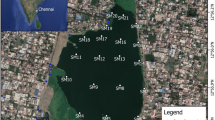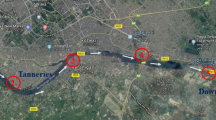Abstract
The Nyabugogo natural wetland (Kigali City, Rwanda) receives all kinds of untreated wastewaters, including those from industrial areas. This study monitored heavy metal concentrations (Cd, Cr, Cu, Pb, and Zn) in all environmental compartments of the swamp: water and sediment, the dominant plant species Cyperus papyrus, and fish (Clarias sp. and Oreochromis sp.) and Oligochaetes. Cr, Cu, and Zn concentrations in the water were generally below the WHO (2008) drinking water standards, whereas Cd and Pb were consistently above these limits. Except Cd, all metal concentrations were below the threshold levels for irrigation. The highest metal accumulation occurred in the sediment with up to 4.2 mg/kg for Cd, 68 mg/kg for Cu, 58.3 mg/kg for Pb, and 188.0 mg/kg for Zn, followed by accumulation in the roots of C. papyrus with up to 4.2 mg/kg for Cd, 45.8 mg/kg for Cr, 29.7 mg/kg for Cu, and 56.1 mg/kg for Pb. Except Cu and Zn, other heavy metal (Cd, Cr, and Pb) concentrations were high in Clarias sp., Oreochromis sp., and Oligochaetes. Therefore, there is a human health concern for people using water and products from the swamp.




Similar content being viewed by others
References
Aksoy, A., Demirezen, D., & Duman, F. (2005). Bioaccumulation, detection and analyses of heavy metal pollution in Sultan Marsh and its environment. Water, Air, and Soil Pollution, 164, 241–255.
Allen, S. E. (1989). Chemical analysis of ecological materials (2nd ed.). Oxford: Blackwell Scientific.
American Public Health Organisation (1992). Standards methods for examination of water and wastewater 18th edn.
Amri, N., Benslimane, M., Zaoui, H., Hamedoun, M., & Outiti, B. (2007). Evaluation of the heavy metals accumulate in samples of the sediments, soils and plants by ICPOES with the average Sebou. http://www.fsr.ac.ma/MJCM/vol8-art08.pdf (Accessed 10 August 2009).
Azza, N. G. T., Kansiime, F., Nalubega, M., & Denny, P. (2000). Differential permeability of papyrus and Miscanthidium root mats in Nakivubo swamp, Uganda. Aquatic Botany, 67, 169–178.
Blackwell, M. S. A., Hogan, D. V., & Maltby, E. (2002). Wetlands as regulators of pollutant transport. In: Haygarth, P. M., Jarvis, S. C. (Eds.), Agriculture, Hydrology and Water Quality. CAB International.
Bonet, A., Poschenrieder, C., & Barcelo, J. (1991). Chromium III–Iron interaction in Fe-deficient and Fe-sufficient bean plants. I. Growth and nutrient content. Journal of Plant Nutrition, 14, 403–414.
Denny, P. (1987). Mineral cycling by wetland plants—A review. Arch Hydrobiol Beich Ergebn Limnol, 27, 1–25.
Denny, P. (1995). Heavy metal contamination of Lake George (Uganda) and its wetlands. Hydrobiologia, 257, 229–239.
Denny, P., Bailey, R., Tukahirwa, E., & Mafabi, P. (1995). Heavy metal contamination of Lake George (Uganda) and its wetlands. Hydrobiologia, 297(3), 229–239.
Du Laing, G., De Vos, R., Vandecasteele, B., Lesage, E., Tack, F. M. G., & Verloo, M. G. (2008). Effect of salinity on heavy metal mobility and availability in intertidal sediments of the Scheldt estuary. Estuarine, Coastal and Shelf Science, 77, 589–602.
EPA (2009). Online series. Drinking water contaminants. Specific fact sheets for consumer. http://www.epa.gov/safewater/contaminants/index.html. Accessed 5 November 2009.
EU (2001) Commission Regulation as regards heavy metals, Directive 2001/22/EC, No: 466/2001.
Ewers, U., & Schlipkoter, H. W. (1991). Intake, distribution and excretion of metal compound in humans and animals. In: Merian E. Metals and their compound in the environment; occurrence, analysis and biological relevance. VCH Weiheim, pp. 571–583.
Fleming, C. A., & Trevors, J. T. (1989). Copper toxicity and chemistry in the environment: A review. Water, Air, and Soil Pollution, 44, 143–158.
Jones, L. H. P., Clement, C. R., & Hopper, M. J. (1973). Lead uptake from solution by perennial ryegrass and its transport from roots to shoots. Plant and Soil, 38, 403–414.
Judith, S. W., & Peddrick, W. (2004). Metal uptake, transport and release by wetland plants: Implications for phytoremediation and restoration. Environment International, 30, 685–700.
Kalay, M., Ay, Ö., & Canli, M. (1999). Heavy metal concentrations in fish tissues from the Northeast Mediterranean Sea. Bulletin of Environmental Contamination and Toxicology, 63, 673–681.
Kansiime, F., & Nalubega, M. (1999). Wastewater treatment by a natural wetland: The Nakivubo Swamp, Uganda, processes and implications. Rotterdam: A.A. Balkema.
Kansiime, F., Saunders, M. J., & Loiselle, S. A. (2007). Functioning and dynamics of wetland vegetation of Lake Victoria: An overview. Wetlands Ecology and Management, 15, 443–451.
Kelderman, P., & Osman, A. A. (2007). Effect of redox potential on heavy metal binding forms in polluted canal sediments in Delft (The Netherlands). Water Research, 41, 4251–4261.
Kelderman, P., Drossaert, W. M. E., Zhang, M., Galione, L., Okwonko, C., & Clarisse, I. A. (2000). Pollution assessment of the canal sediments in the city of Delft (The Netherlands). Water Research, 34, 936–944.
Kersten, M. (1988). Geochemistry of priority pollutants in anoxic sludges: Cadmium, arsenic, methyl mercury, and chlorinated organics. In W. Salomons & U. Forstner (Eds.), Chemistry and biology of solid waste (pp. 170–213). Berlin: Springer-Verlag.
MacDonald, D. D., Ingersoll, C. G., & Berger, T. A. (2000). Development and evaluation of consensus-based sediment quality guidelines for freshwater ecosystems. Arch Contam Toxicol, 39, 20–31.
Manios, T., Stentiford, E. I., & Millner, P. A. (2003). The effect of heavy metals accumulation on the chlorophyll concentration of Typha latifolia plants, growing in a substrate containing sewage compost and watered with metaliferous water. Ecological Engineering, 20, 65–74.
Maret, T. R., Cain, D. J., Mac Coy, D. E., & Short, T. M. (2003). Response of benthic invertebrate assemblages to metal exposure and bioaccumulation associated with hard-rock mining in northwestern streams, USA. Journal of the North American Benthological Society, 22(4), 598–620.
Mays, P. A., & Edwards, G. S. (2001). Comparison of heavy metal accumulation in a natural wetland and constructed wetlands receiving acid mine drainage. Ecological Engineering, 16, 487–500.
Mitsch, W. J., & Jørgensen, S. E. (1989). Ecological engineering: An introduction to ecotechnology. New York: Wiley.
Mitsch, W. J., & Jørgensen, S. E. (2004). Ecological engineering and ecosystem restoration. New York: Wiley.
Monday, S. L., Kansiime, F., Denny, P., & James, S. (2003). Heavy metals in Lake George, Uganda, with relation to metal concentrations in tissues of common fish species. Hydrobiologia, 499, 83–93.
Nabulo, G., Oryem, O. H., Nasinyama, G. W., & Cole, D. (2008). Assessment of Zn, Cu, Pb and Ni contamination in wetland soils and plants in the Lake Victoria basin. International Journal of Environmental Science and Technology, 5(1), 65–74. http://ijest.indexcopernicus.com/abstracted.php?level=4&idissue=751301 Accessed 18 January 2010.
Perkin Elmer (1996). Analytical methods for atomic absorption spectroscopy.
Ross, S. M., & Kaye, K. J. (1994). The meaning of metal toxicity in soil-plant systems. In S. M. Ross (Ed.), Toxic Metals in Soil-Plant Systems (pp. 27–61). Chichester, UK: John Wiley and Sons.
Rutunga, V., Kurt, G. S., Karanja, N. K., Gachene, C. K. K., & Nzabonihankuye, G. (1998). Continuous fertilization on non-humiferous acid Oxisols in Rwanda “Plateau Central”: Soil chemical changes and plant production. Biotechnology, Agronomy, Society and Environment, 2(2), 135–142.
Smolders, E., Waegeneers, N., Lison, D., Veroughstraete, V., & De Backer, L. (2003). The EC risk assessment of Cadmium (report available on http://www.icsu-scope.org/cdmeeting/2003meeting/abs_Smolders_etal.htm) Accessed 21 October 2009.
Van Straalen, N. M., Donker, M. H., Vijver, M. G., & Van Gestel, C. A. M. (2005). Bioavailability of contaminants estimated from uptake rates into soil invertebrates. Environmental Pollution, 136, 409–417.
Verhoeven, J. T. A., Arheimer, B., Yin, C. Q., & Hefting, M. M. (2006). Regional and global concerns over wetlands and water quality. Trends in Ecology & Evolution, 21, 96–103.
Verma, S., & Dubey, R. S. (2003). Lead toxicity induces lipid peroxidation and alters the activities of antioxidant enzymes in growing rice plants. Plant Science, 164, 645–655.
Walker, J. D., & Hurl, S. (2002). The reduction of heavy metals in stormwater wetland. Ecological Engineering, 18, 407–414.
WHO (2006). Guidelines for the safe use of wastewater, excreta and grey water. Volume 2 wastewater use in agriculture.
WHO (2008). Guidelines for Drinking-Water Quality, 3rd edition First Addendum to the 3rd edition Volume 1 recommendations (Vol. 1) WHO, Geneva, Recommendations.
Williams, L. E., Pittman, J. K., & Hall, J. L. (2000). Emerging mechanisms for heavy metal transport in plants. Biochimica et Biophysica Acta, 1465(12), 104–126.
Zayed, A., Gowthaman, S., & Terry, N. (1998). Phytoaccumulation of trace elements by wetland plants: I. Duckweed. Journal of Environmental Quality, 27, 715–721.
Zedler, J. B., & Kercher, S. (2005). Wetland resources: Status, trends, ecosystem services, and restorability. Annu Rev Environ Resources, 30, 39–74.
Acknowledgments
The authors are grateful to the Dutch Government and the National University of Rwanda for the financial support provided for this research through the NPT/RW/051 Project.
Author information
Authors and Affiliations
Corresponding author
Rights and permissions
About this article
Cite this article
Sekomo, C.B., Nkuranga, E., Rousseau, D.P.L. et al. Fate of Heavy Metals in an Urban Natural Wetland: The Nyabugogo Swamp (Rwanda). Water Air Soil Pollut 214, 321–333 (2011). https://doi.org/10.1007/s11270-010-0426-9
Received:
Accepted:
Published:
Issue Date:
DOI: https://doi.org/10.1007/s11270-010-0426-9




